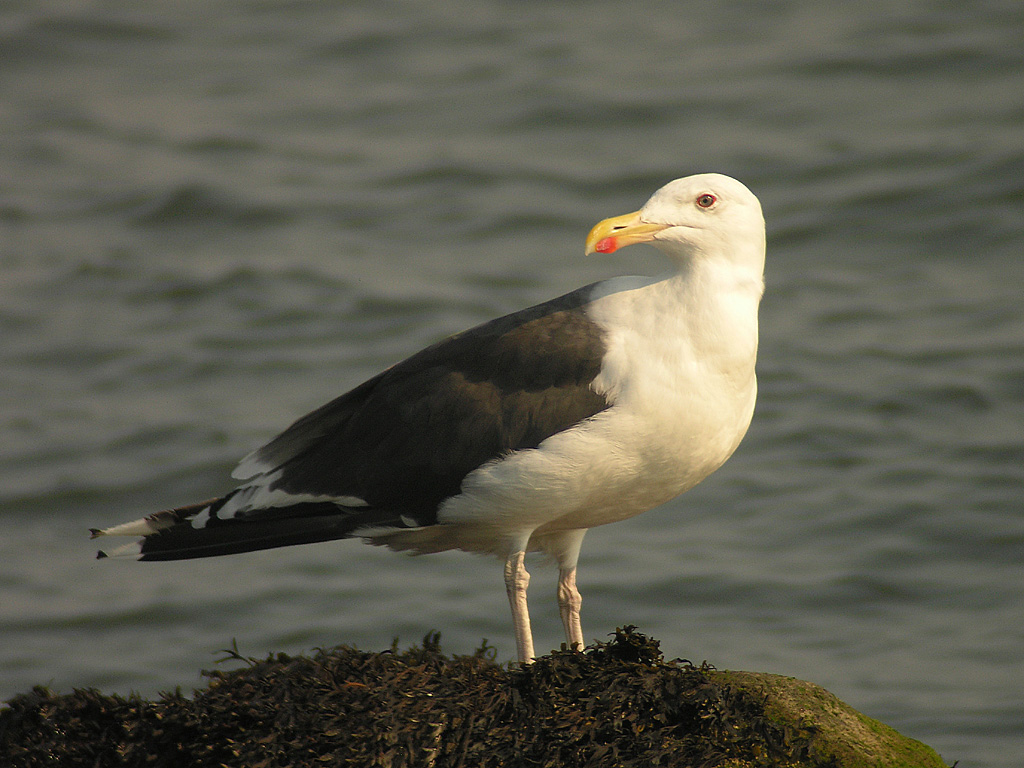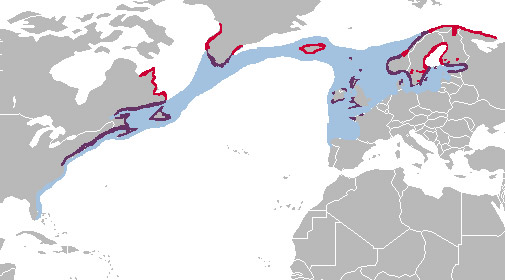- Great Black-backed Gull
Taxobox
name = Great Black-backed Gull
status = LC | status_system = IUCN3.1

image_width = 250px
regnum =Animal ia
phylum = Chordata
classis = Aves
ordo =Charadriiformes
familia = Laridae
genus = "Larus "
species = "L. marinus"
binomial = "Larus marinus"
binomial_authority = Linnaeus,1758 ,Gotland ,Sweden
range_
range_map_caption= Distribution across theNorthern Hemisphere The Great Black-backed Gull, "Larus marinus", is a very large
gull which breeds on theEurope an andNorth America n coasts and islands of the North Atlantic. It is fairly sedentary, but some Great Black-backed Gulls move further south or inland to large lakes or reservoirs.The Great Black-backed Gull was one of the many species originally described by Linnaeus in his 18th century work, "
Systema Naturae ", and it still bears its original name of "Larus marinus". [la icon cite book | last=Linnaeus | first=C | authorlink=Carolus Linnaeus | title=Systema naturae per regna tria naturae, secundum classes, ordines, genera, species, cum characteribus, differentiis, synonymis, locis. Tomus I. Editio decima, reformata. | publisher=Holmiae. (Laurentii Salvii). | date=1758]This is the largest gull, much bigger than a
Herring Gull and is often described as the King of Gulls. [UK Bird Holidays Guide: Oman http://www.birdholidays.co.uk/oman%202008.htm] It is 61-74 cm (24-28 in) long with a 1.4-1.7 m wingspan, the large adult males often weighing in at more than 2 kilogrammes. It is bulky, and has a powerful bill. The adults have black wings and back, with conspicuous white "mirrors" at the wing tips. The legs are pinkish, and the bill yellow with a red spot.Young birds have scaly black-brown upperparts, and a neat wing pattern. They take at least four years to reach maturity, development in this species being somewhat slower than that of other large gulls. The call is a deep "laughing" cry.
Unlike most "Larus" gulls, Great Black-backed Gulls are mostly carnivorous and frequently
hunt and kill any prey smaller than themselves, behaving more like a raptor than a typicallarid gull, though they will also scavenge. They frequently rob otherseabird s of their catch and have been known to follow feedingHumpback Whale s in order to catch fish driven to the surface by the whale. They can swallow apuffin or a small wildduck whole.This species breeds singly or in small colonies, making a lined nest on the ground often on top of a rocky stack. 1-3 eggs are laid. Young Great Black-backed Gulls leave the nest area at 50 days of age and may remain with their parents for months afterwards - though most fledglings choose to congregate with other immature gulls in the search for food. [http://www.birds.cornell.edu/AllAboutBirds/BirdGuide/Great_Black-backed_Gull_dtl.html#coolfacts All About Birds: Great Black-backed Gull ] ]
Gallery
References
* Database entry includes justification for why this species is of least concern
* "National Geographic" "Field Guide to the Birds of North" "America" ISBN 0-7922-6877-6
*" Seabirds" by Peter Harrison, ISBN 0-7470-1410-8
*"Handbook of the Birds of the World Vol 3", Josep del Hoyo editor, ISBN 84-87334-10-5
*"National Audubon Society" "The Sibley Guide to Birds", by David Allen Sibley, ISBN 0-679-45122-6
* Malling Olsen, Klaus and Hans Larsson, "Gulls of Europe, Asia and North America " ISBN 0-7136-7087-8
Wikimedia Foundation. 2010.
